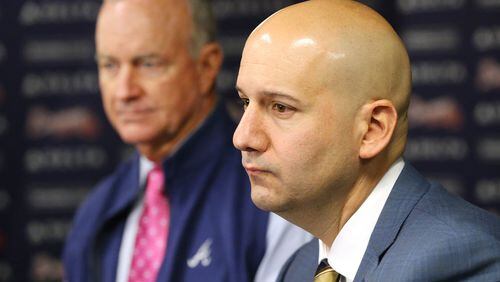At last year’s winter meetings, John Coppolella consummated what stands as the best trade any team has made this century — Shelby Miller to Arizona for Dansby Swanson and Ender Inciarte. The Braves general manager had swung many deals before and has transacted more since, but that’s the one that announced to the world, “We’re smart, we’re fearless and we’re on our way back.”
This year’s meetings open Sunday at Winter Harbor, Md., just across the Potomac from Washington, D.C. There’s a chance the Braves will make a major move there. There’s a better chance they won’t.
A few days ago, Coppolella said over lunch: “I’m telling our staff that if all we do up there is watch John Schuerholz get named to the Hall of Fame, that’ll be fine.”
Just up Cobb Parkway, SunTrust Park was nearing completion. The Braves' new home will open with a March 31 exhibition game against the Yankees. In less time that it takes to build a ballpark, Coppolella and team president John Hart have remade a franchise.
When the Braves' delegation arrived at the Gaylord Opryland Resort last December, it represented a team that had gone 25-57 since July 7. This time they'll check into another Gaylord property as stewards of a club that went 37-35 after the All-Star break, that possesses baseball's best farm system and stands ready to open a shiny new stadium.
If the Braves do nothing of consequence between now and opening day, they'll feel good about their team. This isn't to say they expect to win the National League East next year, but with the offensive surge in the wake of Matt Kemp's arrival — another Coppolella coup — and the addition of Bartolo Colon, R.A. Dickey and Jaime Garcia, the 2017 Braves could well nuzzle up to .500. Lest we forget, this team was on pace to lose more games than Marv Throneberry's Mets not so long ago.
Colon and Dickey — aggregate age: 85 — aren't long-term answers. They're innings-eating stopgaps. Note also that Colon and Dickey cost nothing in the way of prospects, the Braves' most precious commodity. Garcia, the 30-year-old lefty acquired from St. Louis on Thursday, did cost three minor-leaguers. None, however, were prime. As rated by MLB.com, Chris Ellis was No. 17 among the Braves' top 30, John Gant No. 21 and Luke Dykstra No. 29.
As for paying $32.5 million for three short-term arms: It stands to reason that the Braves targeted the offseason before moving to SunTrust as their time to spend (within reason). That’s why the 2015 deals that shed the $38.5 million due Craig Kimbrel, Melvin Upton Jr. and Chris Johnson in 2017 make even more sense now.
Offseason reports have linked the Braves with two pitchers named Chris — Sale of the White Sox, Archer of the Rays. Writing for ESPN Insider, Jeff Sullivan offered a possible package for Sale — shortstop Ozzie Albies and pitchers Sean Newcomb, Kolby Allard, Mike Soroka and Touki Toussaint. Those are the Braves' Nos. 2, 3, 4, 7 and 10 prospects.
Now hear this: That deal at that cost will never happen. Having labored long to propagate this system, Coppolella surely isn’t going to sell that farm, as it were. He’s especially not going to do it for someone who works 35 times a season. (Maybe for Mike Trout, but only for Mike Trout.) If the price drops, one Chris might wind up here — but the guess is that it would have to drop a lot.
Over a similar lunch last fall, Coppolella spoke of franchise-changing trades hatched by the Mets, who dealt Dickey to Toronto for Noah Syndergaard and Travis d’Arnaud, and the Royals, who dealt Zack Greinke to Milwaukee for Lorenzo Cain and Alcides Escobar. Six weeks later, he worked an even greater wonder, landing the No. 1 overall pick in the 2015 draft and an outfielder who’d just posted a WAR (wins above replacement) value of 5.3 at age 25.
Today those players are part of the Braves’ new core: Swanson was summoned from Double-A Mississippi in August and hit .302; Inciarte hit .291 and won a Gold Glove. As gifted as Sale/Archer are, there’s no way the GM who made last December’s Miller trade — a trade that went a long way toward getting Arizona’s front office fired — will put himself on the wrong end of a such a move. With his economics degree, Coppolella will forever be a value shopper.
Case in point: Jason Castro. The Braves had interest in the free-agent catcher, who signed with Minnesota for three years at $24.5 million. If we assume the Braves made an offer, we can also assume it was for less. But the lure of Castro was that he might come cheap. Is $8.13 million a year all that cheap for a guy who, over the past three seasons, has hit .222, .211 and .210?
As it stands, the Braves seem content to head to spring training with Tyler Flowers and Anthony Recker as a catching platoon. But just this week, Coppolella dealt Rob Whalen — a former 12th-round draftee by the Mets acquired by the Braves in the Juan Uribe/Kelly Johnson trade of 2015 – to Seattle for 20-year-old Alex Jackson, the sixth player drafted in June 2014.
An outfielder in the Mariners’ chain, Jackson was a catcher in high school. The Braves would like to try him there again. If Jackson pans out, the Braves will have gotten something for next to nothing. (They have a dozen young pitchers of greater promise than Whalen.) That’s value shopping.
“No stone unturned,” is Coppolella’s mission statement. He might make a dozen trade proposals over these four days and field three dozen more, but he likes the moves he has already made and the farm system he has rebuilt. There’s no pressing need to reap another windfall. Last December’s mega-deal will remain the gift that keeps on giving.
About the Author







